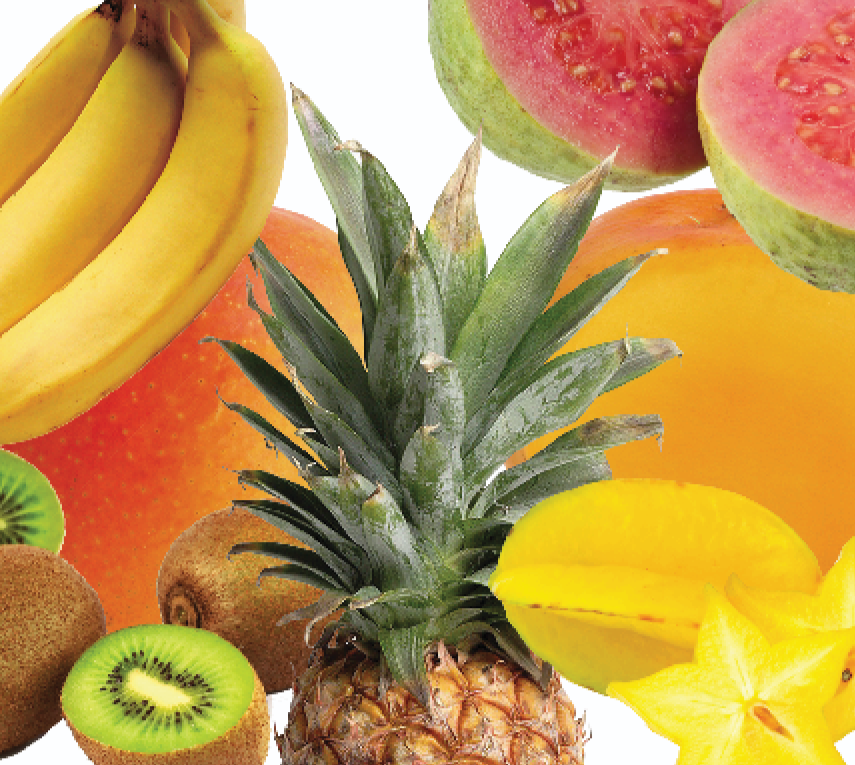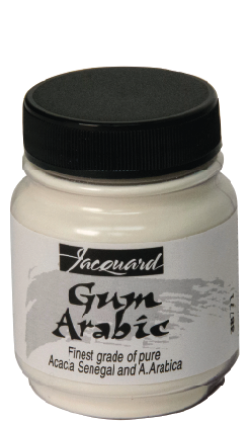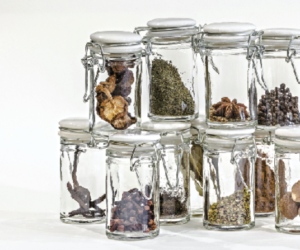
Tropical fruit obviously are those native to the tropics. While the absolute number of fruit native to that area is disputed, at least 235 — more than twice that of the non-tropics — are widely recognized as having culinary significance. Almost all of them are suitable for wine. All factors governing winemaking apply to tropical fruit, plus a few we might not consider.
Most of us are familiar with the names of some of the more common tropicals — banana, carambola (star fruit), custard apple, cherimoya, guava, jujube, kiwifruit, lychee, mango, melons, papaya, passion fruit, pineapple, tamarind, etc. Additionally, there are 43 subtropical fruits, many that overlap into the tropics. The distinction is that tropical fruit cannot tolerate frost while subtropical fruit can tolerate frost for short periods.
Some tropical fruit can be grown quite far north, but they are grown as annuals whereas they may be perennials in the tropics. Examples of this are watermelons, several muskmelon varieties, tomatoes, and most chili pepper varieties.
Factors to Consider
Making wines from tropical fruit involves the same factors as making wine from fruit that is native to temperate regions, plus a few more. The major difference is that those of us in temperate regions may not be as familiar with the inherent characteristics of the tropical fruit as we are with our regional favorites.
How do we know how to approach these fruits? We just analyze the same factors we would in making any fruit wine and look for unusual features.
Natural Sugar Content: If you can obtain pure juice of the fruit you can measure this with a hydrometer or refractometer and use simple math to account for any dilution you might impose. But if the sugar is locked inside denser flesh, you can turn to the Internet and search for nutritional data on the fruit. One excellent source for this information is the SELFNutritionData website at http://nutritiondata.self.com/. They don’t yet have every fruit you might search for, but they are adding new entries all the time. If you can’t find the info there, Google it.
If you will be adding grape juice concentrate or sultanas/raisins to the must to increase body, you also need to factor in that additional sugar content (we will discuss this more later). Factor according to weight (sultanas/raisins) or volume added (concentrate).
Acidity (Titratable Acid): It is best to measure titratable acidity (TA) after the must has been constituted with crushed fruit for an hour or more — measuring after 10 hours of pectic enzyme exposure is better.
There are many different opinions as to the correct acidity for different wines. Taste is the ultimate judge; too low TA will taste dull, flat and lifeless while too high will taste tart, sour and/or bitter. If the acid is just right, the wine should taste lively and crisp. A TA of at least 0.55% contributes to the aseptic quality of the wine — a natural environment inhospitable to most threatening microorganisms. The strategy used here is a TA of 0.60% measured as tartaric for red wines, 0.65–0.70% as tartaric for whites, and as high as 0.85% for sweet wines of either color.
The principal acids in tropical fruit may not be intuitive but the majority are citric, the rest mostly malic, and a very few succinic. Some tropical fruits are included on most tables listing the acids in fruit (see my article “Acidity in Wines,” http://winemaking.jackkeller.net/acid.asp), but with so very many tropical fruit the odds are most will not be listed.
Acidity (pH): Most winemakers will tell you that pH is more important than TA. The reasons for this are beyond the scope of this article (see Bob Peak’s article in this issue on page 52). All I will say is that pH should be measured. If it is above 4.55 the wine is susceptible to microorganisms. If it is below 2.5 the wine will be unpalatable. The perceived correctness for most palates is between 3.2 and 3.8 with 3.4 being the most common “sweet spot” to shoot for.
Astringency: Astringency is that zing we perceive in wine that we don’t detect in the must. Primarily imparted by tannins, other phenolics also are contributors. Taste buds are the best instrument for measuring astringency at home. Your wine either has it or it doesn’t. The trick is balancing it with acidity, alcohol, sugar, and body. If the wine lacks astringency, add grape tannin. If it has too much, fine with PVPP post-fermentation.
Unusual Enzymes: Some tropical fruits contain enzymes that are uncommon to temperate zone fruit. For example, kiwifruit (Chinese gooseberries) are a commercial source for the proteolytic enzyme actinidin, useful as a meat tenderizer, but an allergen to a few (pineapple, mango, banana and papaya also contain lesser amounts of actinidin). Figs contain ficin, an enzyme that aids digestion but also is mildly laxative. The inner lining of the peeling of the papaya is also a natural source of pectinase.
There are dozens of unusual enzymes in tropical fruit. The only way to actually know whether a fruit does or doesn’t contain one or more is to research the individual fruit you want to work with. But don’t get hung up on the biochemistry. If you recognize the fruit as edible and have eaten it without any adverse reaction, don’t be concerned. Just be aware.
Repugnant Flavor: Few fruits truly have repugnant flavor, but for every fruit known to man there is someone who doesn’t like it. However, there are two fruits that tend to rise to the top when speaking of repugnancy: The durian and the Kei apple.
The former actually owes its repugnancy to the odor of the pulp, which smells every bit like rotting meat. But, as we all know, odor is a large contributor to taste, so if you can’t get past the smell the chances are you won’t stomach the taste. Among aficionados the durian is known as the king of fruit. To the less enthusiastic, the taste is somewhat like an onion.
The Kei apple isn’t really repugnant, just far more acidic than any fruit ought to be. But it is that acidity that makes them such a healthy fruit, extremely rich in vitamin C.
Repugnant Odor: The durian, jackfruit, noni, and ginko biloba all have reputations for repugnant odor. I once made wine with jackfruit when my wife was away. Thankfully, the odor of the fruit did not carry over to the wine, but if you’ve ever made homemade garlic wine you’ll have some idea of what my house smelled like while it fermented — only jackfruit is much worse.
Bad Seeds: There are more fruits with toxic seeds in the temperate zones than in the tropics. For example, the seeds of cherimoyas and sugar apples are poisonous, and papaya seeds taste terrible if chewed. Jackfruit seeds are edible and nutritious if roasted or boiled in salt water, but poisonous if eaten raw. Avoid eating any seeds you are unfamiliar with.
Body: With few exceptions, most tropical fruit wines will be thin in body and require a body-building ingredient to increase the mouthfeel. The recipes that start on page 32 compensate for this by adding either frozen grape concentrate or banana water (read on). Alternatively, you can add sultanas or raisins, but these can overwhelm the more subtle and delicate flavors of many tropical fruit. However, the marriage often works well. If using sultanas/raisins (golden or dark), 0.5 pound per gallon (0.23 kg per 3.8 L) of wine is usually sufficient and will also contribute 65% of their weight (5.2 ounces) as natural sugars to the must.
Both red (Concord grape) and white (Niagara grape) frozen grape concentrates — Old Orchard, Welch’s, etc. — are readily available in most North American supermarkets, but may be difficult to find elsewhere. Be sure to read the label. Frozen concentrates contain no yeast-inhibiting additives but most unfrozen ones do. Those sold specifically for winemaking are obvious exceptions.
Undiluted frozen grape juice concentrate (Welch’s) is approximately 61% sugar (189 grams/10.5 fl. oz. red, 195 grams/10.5 fl. oz. white) while raisins are 65% sugar on average.
To incorporate banana into a must, use 1 pound of ripe bananas per gallon of wine (0.4 kg per 3.8 L). Peel the bananas and slice crosswise ¼- to ½-inch thick. Place the slices in one pint of boiling water per pound of banana. Reduce the heat and simmer 20 minutes; strain without squeezing. Retain and cover liquid and set aside to cool. The water should have reduced to about 12 fluid ounces, but whatever the volume is this is the normal amount used in most tropical fruit wine recipes.
Recipes
Guava and Feijoa
Guavas are apple- or pear-shaped, 2–4 inches long, with light yellow or green skin and a white, yellow, pink or red flesh. The ripe flesh is creamy in texture and the skin soft and edible. They contain small, edible seeds. They taste like a cross between a pear and strawberry.
Feijoas are smaller and more elongated with a dark green to bluish-green inedible skin. The pineapple guava is actually a feijoa and tastes like a cross between a pineapple and guava, often with a slight minty flavor. There are many feijoa cultivars offering different flavors. The flesh is granular near the skin but the seed-pulp is clear and jelly-like when ripe and very sweet. If any interior browning is present, the fruit is over-ripe and should not be used for wine.
Guavas should be fermented with the skin intact but not the feijoa. The seeds of both are edible and can be fermented.
Ingredients (yield 1 gal./3.8 L)
2.5–3 lbs. (1.1–1.3 kg) peeled feijoa or
3 lbs. (1.3 kg) guava, chopped and mashed
1.75 lbs. (0.80 kg) granulated sugar
0.5 tsp. tartaric acid
0.25 tsp. malic acid
0.25 tsp. grape tannin
12 fl. oz. (355 mL) banana water
Water to top up to 1 gallon (about 80 fluid oz./2.4 L)
1 tsp. pectic enzyme (powder)
1 finely crushed and dissolved
Campden tablet
1 tsp. yeast nutrient
1 pkg. Champagne wine yeast as a starter solution
Step by Step
Wash the fruit thoroughly before processing. Place the processed fruit in a nylon straining bag, tie closed, and mash the bagged fruit in the primary. Add pectic enzyme, banana water and water. Cover and set aside for 8 to 10 hours, stirring occasionally. Measure the specific gravity (S.G.) and add/adjust sugar to bring S.G. to 1.100, stirring well to dissolve the sugar. Add the remaining ingredients (except yeast). Cover and set aside for 8 to 10 hours. Add the yeast as a starter solution and cover the primary fermenter.
Ferment on the pulp, squeezing the bag daily, until fermentation slows. Squeeze the bag thoroughly and discard pulp. Allow the wine to settle overnight and rack it off the sediments into a secondary fermenter. Top up with water to 1 gallon (3.8 L) and attach an airlock. Rack and top up again after 30 days and set it aside for two months or until the wine clears and the lees compact. If the wine is not clear after two months, rack it again, add 0.25 tsp. pectic enzyme and top up. When it is clear, rack it a final time, add an additional Campden tablet and 0.5 tsp. potassium sorbate, sweeten if desired, and set aside 30 days. Bottle and taste after three months. The wine will continue to improve with age but should be consumed within two years.
Kiwifruit (Chinese gooseberry)
Kiwifruit are ovoid, up to 3 inches long, russet colored and covered with short brown hairs. The flesh is firm until ripe and either bright green, yellowish-gold to brownish or even off-white. Flavor varies from sweet/tart to a sweet cross between banana and melon.
Ingredients (yield 1 gal./3.8 L)
3–4 lbs. (1.3–1.8 kg) kiwifruit, thinly peeled and chopped
1.75 lbs. (0.80 kg) granulated sugar
12 fl. oz. (355 mL) banana water
7 pts. (3.3 L) water
0.75–1.0 tsp. acid blend
0.5 tsp. pectic enzyme
0.25 tsp. grape tannin (powder)
1 tsp. yeast nutrient
1 pkg. Côte des Blancs wine yeast as a starter solution
Step by Step
Add the granulated sugar to the water and bring the mixture to a boil, stirring occasionally until dissolved. Place the peeled, chopped fruit in nylon straining bag, tie closed and put in the primary fermenter. Crush the bagged fruit with your hands. Add acid blend, tannin, and yeast nutrients to the primary and pour the sugar-water over the fruit. Add the banana water, cover the primary and
set aside to cool. When it cools to 110 °F (43 °C) or below, add the pectic enzyme and stir. Cover and set aside 10 to 12 hours. Add the yeast as starter solution and re-cover the primary.
Lift and dunk bag several times daily (do NOT squeeze) and stir. When vigorous (primary) fermentation slows, or on seventh day, (whichever comes first) remove the bag and drip-drain without squeezing, returning the drippings to the primary. Allow the sediment to settle and rack into a secondary fermenter. Add 1⁄16 tsp. of potassium metabisulfite (or one finely crushed and dissolved Campden tablet), stir, top up and attach an airlock. Rack the wine again after three months, refit the airlock, and set it aside for two months or until the wine clears and the lees compact. The wine should be clear and completely dry. If it is too dry for your taste, stabilize, sweeten to your liking, refit the airlock and set aside. After 30 days, rack it into bottles and age for another six months. Serve lightly chilled.
Açai, Dragonfruit, and Mangosteen
These three fruits are widely different, having nothing in common except that they are available to buy as juice (fresh is best for winemaking). They often combined with other juices and sold as “cocktails” or blends, which can contain yeast inhibitors such as potassium sorbate, sorbic acid, sodium benzoate or benzoic acid. Still, all three can be obtained as pure, pasteurized juice with some effort.
Açai (pronounced ah·sigh·ee) is a small berry from the Amazon Basin resembling a black grape with a central seed. The berry is extremely high in antioxidants and other healthy constituents, but also extremely perishable. They must be processed into juice or pulp the same day they are harvested or they spoil. The pure juice tastes like a ripe blackberry infused with dark, unsweetened chocolate, the latter perceived as an aftertaste. It is rich and slightly bitter.
Dragonfruit are the fruit of any of several cactus species belonging to two genus, both originating in Mexico and exported throughout the tropics. One genus produces a more sour fruit, which is juicier, more flavorful and quite refreshing. The other produces a mildly sweet fruit with a kiwifruit-like texture and almost melon-like taste.
Mangosteen, when ripe, have a mild fragrance often described as buttery caramel. Canned juice is available but some of its flavor is lost in the canning process. The delicate flavor is best captured in the juice, but if the juice is blush or reddish it contains astringent (tannic) juices from the outer peel, which by itself is inedible. It is tasty, though, and somewhat more satisfying than the clear juice.
Making wine from açai juice is slightly more difficult than with other berry juice due to the high polyphenols responsible for the slight bitterness in the aftertaste. Use pure white grape concentrate (4 fl. oz./118 mL, undiluted, per gallon/3.8 L of must) or banana water (12–16 fl. oz./355–473 mL per gallon/3.8 L) to help mitigate the bitterness — neither will detract from the color. Natural sugar and acidity should be measured before adjusting to a starting gravity of 1.085–1.090. Use a slower yeast (Assmannshausen is an good choice) and attempt a cool fermentation. Rack as required until clear. Bulk age in the secondary for four to six months before bottling. Oak is not recommended.
Dragonfruit makes a wonderful wine, usually white, but red-pulp dragonfruit exist and make a light blush. Use pure white grape juice concentrate (10.5 fl. oz./311 mL per gallon/3.8 L of must) for body. Acidity can be low to moderate, so measure it. Natural sugars vary, so add sugar to obtain a S.G. of 1.090–1.100. Pectic enzyme will help it to clarify (one tsp. per gallon/3.8 L, powdered). Any white wine yeast will work. Rack until clear, stabilize and then bulk age for three months. Sweeten sparingly and enjoy.
Clear Mangosteen juice, with 10.5 fl. oz. (311 mL) of undiluted pure white grape concentrate. makes an excellent wine. Add sugar to a starting S.G. of 1.080 — higher alcohol is not recommended — and about 1.5 tsp. acid blend per gallon (3.8 L). Pectic enzyme will help with clarity. Stabilize the wine after clearing and bottle 45 to 60 days later. For mangosteen juice with reddish hues use banana water (20 fl. oz./591 mL per gallon/3.8 L of must) instead of grape concentrate. For either juice, use Lalvin BA11 to bring out mangosteen’s aromas but heed its high nitrogen nutrient needs. Bottle this wine dry. If you must sweeten it, stabilize it first and sweeten sparingly.






